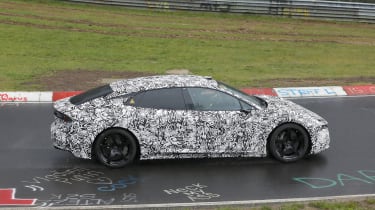New Lotus Emeya electric saloon teased ahead of 7 September reveal
Hethel’s answer to the Porsche Taycan will go on sale early next year
Hot off the launch of the all-electric Lotus Eletre SUV, the British brand is gearing up for the reveal of its next EV: the Lotus Emeya four-door ‘hyper-GT’.
So far, all we know for sure is the Emeya’s name, that it’ll be unveiled on 7th September and that it’s going to sit on the firm’s new Electric Premium Architecture – the same platform that underpins the Eletre.
Of course, Lotus is no stranger to the super saloon. The Vauxhall-based Lotus Carlton was an instant icon when it arrived in the early 90s, but the Emeya is a different proposition altogether.
Instead of rivalling the BMW M5 like the Carlton did in its day, the Emeya will go toe-to-toe with other all-electric saloons including the Porsche Taycan, Audi e-tron GT and Tesla Model S, as well as the Lucid Air in Europe and North America.
The Taycan is expected to be the Emeya’s arch-nemesis however, especially considering the Porsche’s driver-focused nature, and Lotus has begun to hype up the Emeya’s debut on social media using the hashtag ‘#ForTheDrivers’.
The short teaser video and few images Lotus has shared to date don’t reveal much about the Emeya’s design, other than that the front will feature a split headlight signature and sharp nose, while the rear gets a full-width light bar. The other detail we’ve picked up on is the inclusion of digital wing mirrors, however those, along with the design cues we mentioned, are all shared with the Eletre.
Luckily we’ve managed to snap the Emeya undertaking the traditional performance car testing regime at the Nurburgring – a much more natural environment for a Lotus than the frozen lake we previously spotted it testing on.
The spy shots confirm the Emeya will have a menacing, aero-optimised front end with a clear family resemblance to the Eletre, and uses similar solutions to reduce drag. The Eletre’s active grille makes an appearance, consisting of motorised ‘petals’ which open up when extra cooling is required; under normal conditions, the petals remain closed to reduce aerodynamic disturbance.
The headlights are split into two elements, with L-shaped upper lighting strips and larger units set into the front bumper. Interestingly, an extra pair of L-shaped panels are visible on the bonnet of this prototype – whether these are additional light units or active aero panels remains to be seen.
-
New Lotus Eletre 2023 review
At first glance, there's little evidence of Lotus's 'porous' design language, which uses air channels carved into the bodywork to reduce drag. Nevertheless, there are small triangular vents in the outer front bumper to direct air through the wheel arches, and the Eletre's driver assistance hardware – including a roof-mounted LiDAR unit and deployable sensor pods along the flanks – could enable Level 4 autonomous driving later down the line. It appears the rear end will feature an active spoiler, too.
Inside, the Lotus ‘hyper-GT’ will draw heavily from the Eletre’s cabin design and tech, with a hexagonal steering wheel and a suite of digital interfaces likely to feature. The SUV’s 15.1-inch OLED central touchscreen will probably be carried over as well, alongside thin display strips ahead of the driver and passenger set within a two-tiered dashboard.
Battery and powertrain
As we mentioned, the Emeya will use the Electric Premium Architecture used by the Eletre. This means the saloon certainly has the potential to beat, or even exceed, the Taycan’s performance figures. The base Eletre’s 592bhp dual-motor setup could serve as the entry point in the range with similar power to the Taycan GTS, then a potential flagship could be built around the Eletre R’s 893bhp tri-motor setup.
Thanks to its 112kWh battery pack, the Eletre can cover up to 373 miles from a single charge, and the Emeya’s slipperier aerodynamics could see it surpass 400 miles if it uses the same battery. Thanks to the platform’s 800V electronic architecture, peak charging speeds of 350kW are possible, allowing for a 10 to 80 per cent top-up in just 20 minutes, if you use a suitable ultra-rapid charger.
Traditionally, Lotus has traded on beautifully judged handling rather than outright performance, and the firm’s engineers will lean heavily on an advanced suite of chassis electronics to contain the EV’s mass and improve dynamics. These tools – such as active anti-roll bars, rear-wheel steering and adaptive air suspension – are already present in the Eletre.
Expect the Lotus Emeya to have a starting price of less than £100,000 when it goes on sale in early 2024.
Check out of our review of the Lotus Eletre…
Source: Read Full Article



 New Lotus Eletre 2023 review
New Lotus Eletre 2023 review


